Honor Award
Culinary Garden at Kellogg Ranch
Kyle McEnroe, Student ASLA and Ryan Connelly, Student Affiliate ASLA, California State Polytechnic University, Pomona
Faculty Advisors: Susan Mulley, Dan Hostetler and Andrew Feinstein
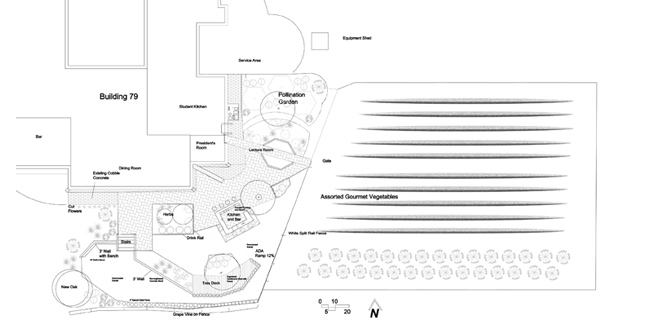 Close Me!
Close Me!The Site Plan creates an interactive learning environment that integrates different colleges within the university through local food production while contributing to the university’s goal of achieving climate neutrality.
Download Hi-Res ImagePhoto: Kyle McEnroe and Ryan Connelly
Photo 1 of 11
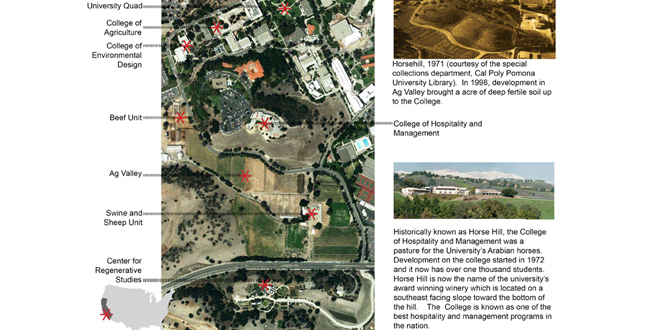 Close Me!
Close Me!The College of Hospitality Management sits on top of what was historically known as Horsehill. In 1998, development in Ag Valley brought up an acre of deep fertile soil to the college.
Download Hi-Res ImagePhoto: Kyle McEnroe and Ryan Connelly
Photo 2 of 11
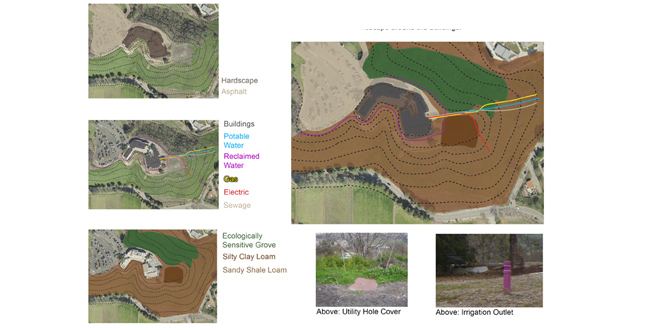 Close Me!
Close Me!Site inventory revealed many opportunities and constraints including existing utility infrastructure, ecologically sensitive areas and changes in topography.
Download Hi-Res ImagePhoto: Kyle McEnroe and Ryan Connelly
Photo 3 of 11
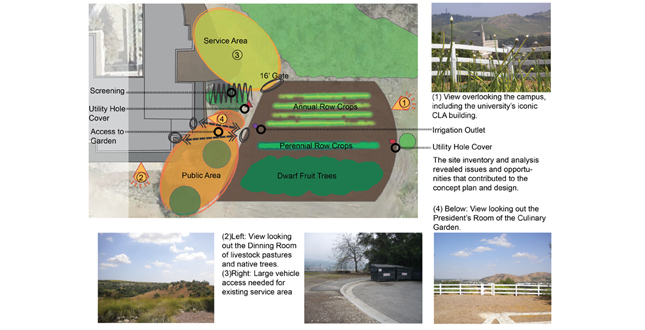 Close Me!
Close Me!The site inventory and analysis revealed issues and opportunities that contributed to the concept plan and design including screening of the service area, circulation patterns and open views.
Download Hi-Res ImagePhoto: Kyle McEnroe and Ryan Connelly
Photo 4 of 11
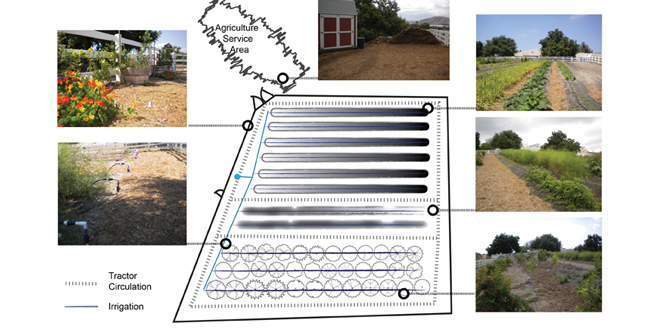 Close Me!
Close Me!Phase one was the establishment of the culinary garden which included a fence, tractor circulation, different types of irrigation, annual row crops, perennial row crops and dwarf fruit trees.
Download Hi-Res ImagePhoto: Kyle McEnroe and Ryan Connelly
Photo 5 of 11
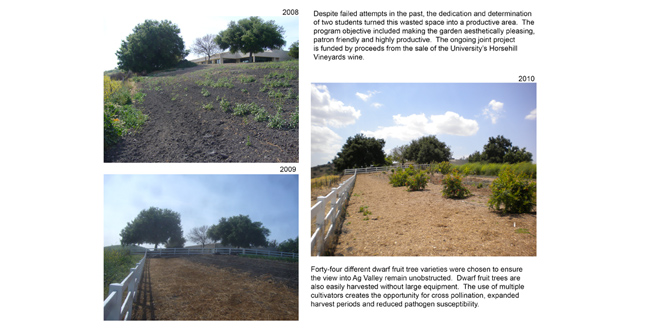 Close Me!
Close Me!Despite failed attempts in the past, the dedication and determination of two students turned this wasted space into a productive area.
Download Hi-Res ImagePhoto: Kyle McEnroe and Ryan Connelly
Photo 6 of 11
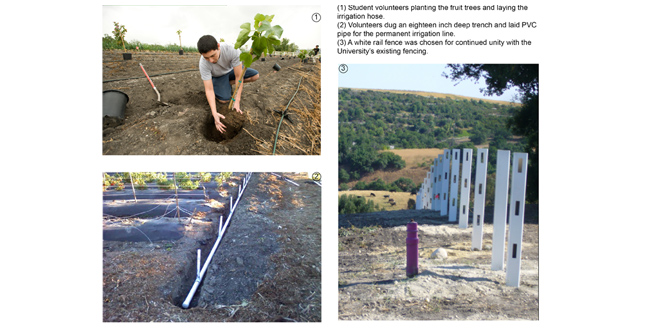 Close Me!
Close Me!The majority of the garden establishment was done by student volunteers.
Download Hi-Res ImagePhoto: Kyle McEnroe and Ryan Connelly
Photo 7 of 11
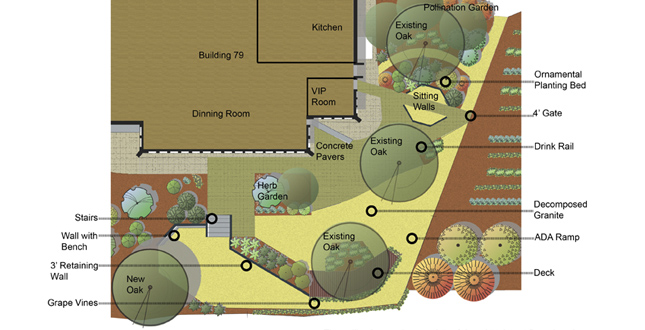 Close Me!
Close Me!Phases two and three include an outdoor lecture room which doubles as a space for classes held on the site and as a gathering space for patrons during special events.
Download Hi-Res ImagePhoto: Kyle McEnroe and Ryan Connelly
Photo 8 of 11
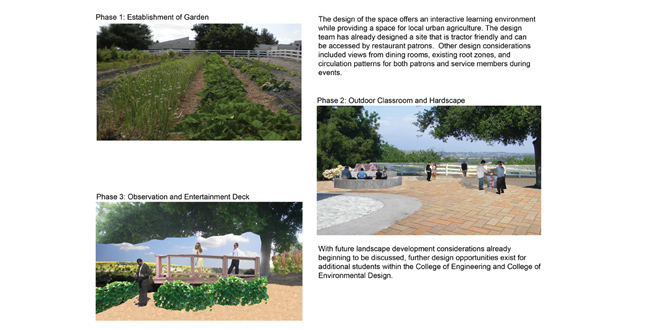 Close Me!
Close Me!The design of the space offers an interactive learning environment while providing a space for local urban agriculture. Other design considerations included views from dining rooms, existing root zones, and circulation patterns for both patrons and service members during events.
Download Hi-Res ImagePhoto: Kyle McEnroe and Ryan Connelly
Photo 9 of 11
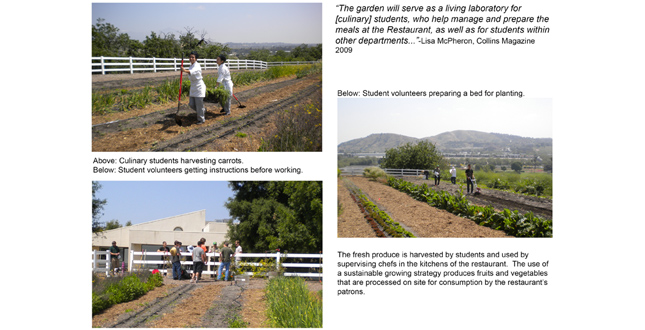 Close Me!
Close Me!The use of a sustainable growing strategy produces fruits and vegetables that are processed on site for consumption by the restaurant’s patrons.
Download Hi-Res ImagePhoto: Kyle McEnroe and Ryan Connelly
Photo 10 of 11
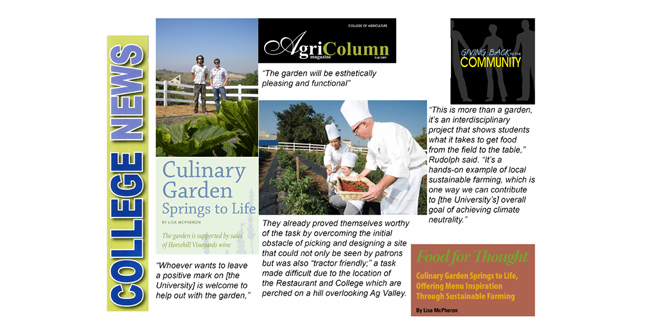 Close Me!
Close Me!This is more than a garden; it’s an interdisciplinary project that shows students what it takes to get food from the field to the table.
Download Hi-Res ImagePhoto: Kyle McEnroe and Ryan Connelly
Photo 11 of 11
Project Statement
Create an interactive learning environment that integrates different colleges within the university through local food production while contributing to the university’s goal of achieving climate neutrality. Use the garden as a living laboratory for new curriculum that teaches skills to students for continued garden maintenance and meal preparation within the restaurant.
Project Narrative
Local Food Production
The partnership between The College of Hospitality Management and the College of Agriculture has transformed a hilltop field outside the restaurant into a culinary local food production unit. It has been said that this project is much more than a garden, “It’s a hands-on example of local sustainable farming, which is one way we can contribute to [the University’s] overall goal of achieving climate neutrality.” –Chef Scott Rudolph
The fresh produce is harvested by students and used by supervising chefs in the kitchens of the restaurant. The use of a sustainable growing strategy produces fruits and vegetables that are processed on site for consumption by the restaurant’s patrons.
The idea of the restaurant producing high quality gourmet food starts and ends at the garden. A growing strategy that utilizes expanded harvesting techniques, integrated pest management, cover cropping and a nutrient management strategy has effectively produced food for over two years at the restaurant’s student-operated garden. A small on-site composting operation uses natural microorganisms to break down the carbon and nitrogen harvested from the crops to amend and help build a healthy soil. The use of advanced irrigation products and techniques, along with reclaimed water has had a profound effect on the crop yield. Having students on-site and available to harvest ensures a fresh crop. The proximity of the garden to the student kitchen is another opportunity to decrease the carbon footprint associateed with conventional agricultural production distrubution channels.
Integrating Colleges
The establishment and continued maintenance of the project has integrated California State Polytechnic University’s College of Environmental Design, College of Agriculture and Collins College of Hospitality Management. Chef Scott Rudolph has said that “This is more than a garden; it’s an interdisciplinary project that shows students what it takes to get food from the field to the table.” With future landscape development considerations already beginning to be discussed, additional design opportunities exist for additional students within the College of Engineering and College of Environmental Design. In addition to the establishment of the garden, curriculum has been developed that further integrates the College of Agriculture and the Collins College of Hospitality Management. Culinary Produce is an upper level class that strengthens the relationship between the students of the two colleges by utilizing basic growing and cooking skills possessed by the respective students while teaching important programming skills needed for successful collaboration.
Interactive Learning Environment
The university’s polytechnic approach to learning has provided a solid base for the success of the project. The garden is serving as a living laboratory for a number of interested students who help manage and prepare meals at the restaurant along with students that meet the challenges associated with managing a garden of this caliber. The design team has already overcome the initial obstacle of choosing and designing a site that can be accessed by restaurant patrons and is also “tractor friendly;” a challenging task due to the location of the restaurant which is perched on a hill overlooking ‘Ag Valley’.
Programming Intention
A program objective of the culinary garden set forth by the directors of development included making the garden aesthetically pleasing, patron friendly and highly productive. The ongoing joint project is funded by proceeds from the sale of the University’s Horsehill Vineyards wine. The maintenance of the garden is provided by student volunteers from various clubs, organizations and interests.
Design Elements
The design of the space offers an interactive learning environment while providing a space for local urban agriculture. Phases two and three include an outdoor lecture room which doubles as a space for classes held on the site and as a gathering space for patrons during special events. Drink rails and sitting walls accent assets such as views into the valley and shade from mature oak trees to create gathering spaces. Other design considerations for these phases included views from dining rooms, existing root zones, and circulation patterns for both patrons and service members during events. The pollination garden consists of drought tolerant flowering plants to provide habitat for beneficial insects needed for biological activity within the garden. The ornamental horticulture planting area consists of low growing horticultural plants that will not obstruct the view from the President’s VIP room and are not currently found on campus but are needed for plant identification courses. Students involved in intercollegiate plant competitions will directly benefit from this planting area for identification purposes.
This design incorporates local food production, education, and function for the College of Hospitality Management and their restaurant, the College of Agriculture, and the College of Environmental Design.
Additional Project Credits
Dr. Fred Roth
Kelly Duke
Andy Wilcox
Bud Sutton
Lori Pullman
Eudell Vis
Anna Marie Barlet
Dr. Greg Partida





